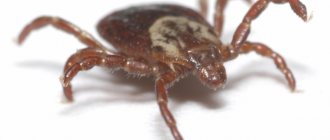Dangerous consequences
Is every parasite dangerous for a pet? What types of ticks are at risk?
All known:
- Ixodes;
- Dermacentor reticulatus;
- Haemaphysalis;
- Hyalomma;
- Rhipicephalus and others.
Take a look at the photos to remember what they look like - they differ slightly in appearance. The main harm is that ticks are a common carrier of serious diseases.
Titles:
- piroplasmosis;
- bartonellosis;
- borreliosis;
- hepatozoonosis;
- ehrlichiosis.
In some cases, a bite can cause not just a slight inflammation, but a more dangerous reaction - a local or neurotoxic type.
When the ambient temperature rises above 8 degrees Celsius, ixodid ticks become active. Owners of dogs and cats have a lot of misconceptions about them.
First, the dog can get tick-borne encephalitis. Dogs and cats do not get tick-borne encephalitis. And they cannot infect the owner with it. So there is no need to worry and take the tick to the laboratory for analysis. But the dog can get sick with the so-called. vector diseases - piroplasmosis, ehrlichiosis, anaplasmosis, borelliosis, dirofilariasis. Fortunately, St. Petersburg and the Leningrad Region are relatively safe, and cases of the disease are relatively rare. Our doctors encounter piroplasmosis only a few times during the entire season, although many dogs are brought to the clinic every day to remove attached ticks. . But if you travel with your pet south of the Leningrad region, for example, to the Moscow region, Belarus and the southern regions of the country, then the probability of getting sick at the first bite is very high.
For prevention, owners use drops on the withers, tablets, collars, and another misconception is that they help prevent vector diseases. Most drops on the withers, collars and tablets only work when a tick has bitten a dog or cat and has sucked blood. Then he receives a portion of insectoacaricide and dies. In order to prevent diseases transmitted by ticks, we need repellents that repel ticks. These include various sprays containing fipronil and pyrethroids, collars with essential oils and other repellents. Therefore, for more reliable protection, use combined methods, for example, spray and drops on the withers, or a collar and tableted insectoacaricide. Especially if you are traveling to an area unfavorable for piroplasmosis and other vector diseases.
If your pet is nevertheless bitten by a tick, it must be removed with a special twister, which is sold in pet stores, or simply with a thread tied at the base of the tick. The bite wound is treated with iodine or brilliant green and the dog is monitored. Signs of vector diseases are high (about 40 degrees) temperature, dark or bloody urine, lameness due to joint pain, pale gums, shortness of breath, and swollen lymph nodes. . If your dog shows these signs within a few days or weeks, you should immediately consult a veterinarian, because some of these diseases are life-threatening for the animal. To prevent dirofilariasis (“heartworm disease”), you need to treat the dog with drops on the withers, or give a tablet inside that kills heartworm larvae.
Health to you and your pets.
Chief veterinary doctor Fomina Ksenia Lvovna.
Tick paralysis: neurotoxic reaction
The consequence is not a disease, but a reaction of the dog’s body to a tick-borne toxin that enters the animal’s bloodstream when bitten. Paralysis can have varying degrees:
- hind limbs;
- with transition to the pelvic area;
- all limbs;
- dysphagia – the dog cannot swallow normally;
- dysfunction of the vocal apparatus - partial or complete;
- shortness of breath - up to suffocation.
Is treatment always necessary? Only a veterinarian can answer this question - it all depends on the degree of paralysis and the age of the bite. In any case, the pet must be shown to a specialist.
Diseases caused by tick bites
In veterinary medicine, more than a dozen diseases are known that are caused by tick bites, five of them are leading in confirmed diagnoses throughout the world. Many of them are dangerous for both dogs and people.
Piroplasmosis (babesiosis)
Piroplasmosis (babesiosis) is a viral blood disease caused by the single-celled parasite Babesia canis (Piroplasma canis). Dogs and other predatory animals become infected with piroplasmosis. The carrier is a pasture tick; the virus is transmitted in saliva during a bite.
The life cycle of the pathogen has not been studied, but it is known that it parasitizes red blood cells, destroying them. After infection, the first symptoms appear within 1–4 days. Symptoms are more severe in older dogs. The severity of the condition may vary depending on the number of viral cells.
The first symptom that is often missed is anemia, after which the clinical picture develops as follows:
- Temperature increase.
- Weakness and apathy.
- Decreased appetite.
- Vomiting, diarrhea.
- Decreased temperature and signs of intoxication.
- Complete refusal to eat.
- Weakness in hind limbs.
- Tremor.
- Discoloration of urine the color of dark beer.
- Jaundice.
- Acute liver failure.
Less commonly, the clinical picture is accompanied by renal failure, skin rashes, and blockage of blood vessels. If a young dog is infected and does not receive treatment, there is a good chance that the virus will be naturally suppressed.
In the absence of treatment, piroplasmosis does not stop, but becomes chronic, that is, the symptoms periodically recur until the disease leads to depletion of the name system and the dog dies.
Piroplasmosis is diagnosed in three ways:
- Symptoms: usually. at the stage of dark urine and weakness in the hind limbs, the clinical picture is indisputable.
- By studying muscle tissue.
- Through a blood test - laboratory or rapid test.
Local reaction: local inflammation
The skin disorder most often manifests itself as a normal reaction of the body to tick saliva. Common symptoms that occur a couple of hours after the parasite is removed:
- redness at the site of the bite;
- edema;
- increased body temperature;
- pain or itching.
In order to avoid unwanted dog behavior - scratching the wound - it is necessary to properly treat it and close access to it with a bandage. Otherwise, purulent inflammation will begin - granulomatous dermatitis.
The process of helping a dog
What to do to save a dog
In order to save your pet, it is necessary to provide him with first aid in a timely manner. Unhook the tick from the skin, place it in a jar and take it to the doctor, where tests will be performed. The analysis is carried out in order to identify pathogens and understand whether the tick was infected. This is important in order to begin treatment of the animal as quickly as possible.
How to remove a tick?
It is necessary to create a barrier to prevent oxygen from passing through. To do this, you can use: oil, rich cream, nail polish or rich soap foam. If necessary, you can trim the hair in the area where the tick is attached to make it easier to remove. Apply oil or other suitable substance to the tick. Needs to be applied every 5 minutes.
After 10-15 minutes, the ticks can be moved with your fingers. This means you can proceed with immediate removal. The tick is removed by twisting movements in any direction - clockwise or counterclockwise. Tools you can use are tweezers, thread or other suitable tool. There are special hooks for unscrewing pincers. The tick must be captured as close to the skin as possible - this is important! If you grab it by the body, you can crush the tick. The safest method is to use thread.
The thread is draped over the tick so that a loop is formed, which is tightened. As soon as the thread has tightly grasped the tick's head, you can scroll it, slightly pulling it up. During the process of removing the tick, the dog will feel almost nothing. But as soon as the head of the tick comes out of the skin, the dog will feel a prick and may buck.
Therefore, it is necessary for someone to hold the dog so that it does not make sudden movements. Once the tick is removed, it is placed in a jar of oil. Be sure to cover it with a lid, as it can escape. It is best to burn it, as ticks go into suspended animation, but after a while they can wake up and continue hunting.
But do not forget that before destroying a tick, it must be tested to identify diseases that the tick may carry.
If, when removing the tick, its head remains in the dog’s body, then no emergency measures can be taken. The head of a tick in a dog’s body is a foreign element that the dog’s body will begin to fight. If the dog does not have any health problems, the head of the tick will become covered with a blister and will come out along with the resulting pus. There will be swelling or inflammation at the site of the bite. It is important to monitor the dog's condition. If the temperature rises or other symptoms appear, you should immediately contact a veterinarian. The veterinarian opens and cleans the inflamed area.
Tick-borne encephalitis
The most serious disease, which is most often contracted in the spring. How dangerous it is can be judged by the consequences of its occurrence:
- limb spasms;
- complete paralysis of the whole body;
- impairment of visual function - until its complete loss;
- similarly – with the sense of smell;
- epilepsy;
- fainting.
What does an animal with encephalitis look like:
- behaves lethargically, stops eating;
- aggression may occur;
- immobilized.
The disease causes swelling of the brain and spreads to the spinal and other vital systems. Potent drugs are used as therapeutic drugs, and their introduction into the body must be done without delay.
Erlisiosis
The most characteristic symptom, which in the absence of adequate treatment leads to death, is high fever. The disease begins with lethargy and weakness. The dog refuses to play and move and tends to lie down more. The disease affects important organs - vision, digestion, brain, circulatory system.
Since any bite is dangerous, contact your veterinarian immediately - a timely blood test will help avoid serious problems in the future.











